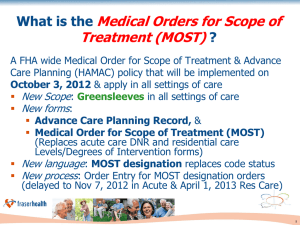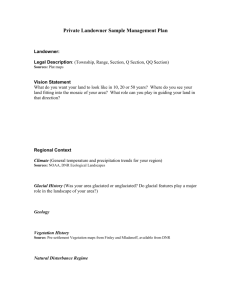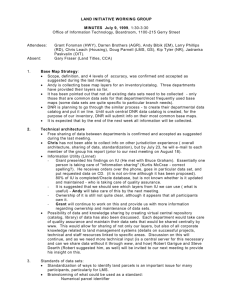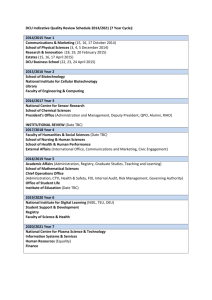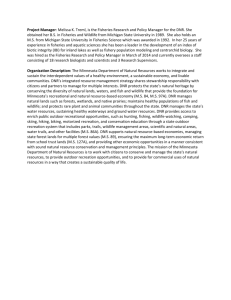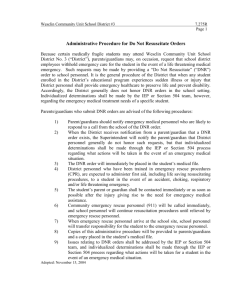CADSI NAvy Outlook 2014 - Southern Ontario Defence Association
advertisement
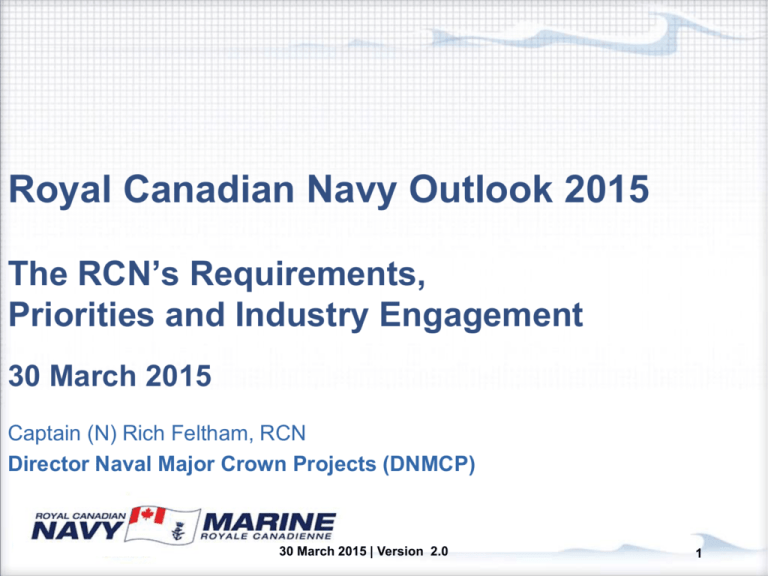
Royal Canadian Navy Outlook 2015 The RCN’s Requirements, Priorities and Industry Engagement 30 March 2015 Captain (N) Rich Feltham, RCN Director Naval Major Crown Projects (DNMCP) 30 March 2015 | Version 2.0 1 Outline • About DNR / DNMCP • Team & Responsibilities • The Plan • Roadmaps • Priorities 30 March 2015 | Version 2.0 2 DNR Responsibilities • Capability Development – Future Capital Acquisition • Project Directorship – Underway Capital Acquisition – Requirements Definition • Managing the Requirements Portfolio – – – – – – – Unforecasted Operational Requirements Joint Requirements Matrix-ing (working in NDHQ) Allies and their Capital Programmes Engagement with Industry Engagement of Allies Engagement of R&D Staffs 30 March 2015 | Version 2.0 3 Directorate of Naval Requirements (DNR) DNR Capt Wade Carter, RCN 819-939-3954 Capability Areas Maritime Domain Awareness & ISTAR Platform Requirements, & MCDV, MCM, Diving, etc Above Water Warfare Requirements Under Water Warfare & Training & Simulation Communications and Information Systems CPC Cdr David Coffey 819-939-3951 Class DNR 2 Cdr Simon Nadeau 819-939-3949 DNR 3 Cdr Rollie Leyte 819-939-3946 DNR 8 Cdr Scott Godin 819-939-3973 DNR 4 Cdr Mike McEntee 819-939-3986 DNR 9 Cdr Paul Sutherland 819-939-3976 Halifax Class Modernization Submarine Requirements DNR 5 Cdr Al Fry 819-939-3969 DNR 6 Cdr Andy Samoluk 819-939-3971 30 March 2015 | Version 2.0 4 DNMCP Responsibilities • New Directorate in Director General Naval Force Development (DGNFD) • Project Directorship – Concerned with three Naval Major Crown Projects: – Arctic / Offshore Patrol Ship (AOPS) – Joint Support Ship (JSS) – Canadian Surface Combatant (CSC) 30 March 2015 | Version 2.0 5 Directorate of Naval Major Crown Projects (DNMCP) DNMCP Capt(N) Rich Feltham, 819-934-0437 CSC Cdr Scott Shortridge 819-997-2257 JSS Cdr Fred Caron 819-997-7622 30 March 2015 | Version 2.0 AOPS Cdr Trevor MacLean 819-997-7325 6 2015 - Capital Investment Plan AOPS Arctic Offshore Patrol Ship (AOPS) RMDS BSSU Bow Sonar System Upgrade (BSSU) RSSLE Route Survey System Life Extension (RSSLE) Remote Minehunting and Disposal System CISU Communications Intercept Suite Upgrade (CISU) SB StrongBow (SB) CSC Canadian Surface Combatant (CSC) SCLE Submarine Capability Life Extension (SCLE) SECLA Secure Local Area Network (SecLAN) N Global Command and Control System - Maritime (GCCS-M) GCCS SELEX Submarine Equipment Life Extension (SELEX) Ver 4.X CUMA Canadian Underwater Mine Warfare Apparatus (CUMA) HCM HALIFAX Class Modernization (HCM/FELEX) SERC Submarine Escape & Rescue Capability (SERC) HWTU Heavy Weight Torpedo Upgrade (HWTU) SIRIUS HCM/ SIRIUS ISTAR RCN ISTAR Program - TCDL, CSD, UAV (ISTAR) SNR Sub Net Relay (SNR) JSS SSD Surface Supplied Diving (SSD) KHSDC KINGSTON Class High Speed Data Connection (KHSDC) TTCU Towed Torpedo Countermeasures Upgrade (TTCU) LWTU Light Weight Torpedo Upgrade (LWTU) UWSU Underwater Warfare Suite Upgrade (UWSU) Joint Support Ship (JSS) MENAC Maritime Next Generation Radio Suite (MeNaCe) E MRB Multi Role Boat (MRB) MSCU Maritime Satellite Communications Upgrade Project (MSCU) MTC2 Maritime Tactical Command and Control (MTC2) NEARO Naval Electronic Attack Recapitalization Onboard (NEARO) NEWSS Naval Electronic Warfare System Sub Surface (NEWSS) NEWS Naval Electronic Warfare System Surface (NEWSU) U NICE Naval Improved Clothing and Equipment (NICE) NLT Naval Large Tug (NLT) NRWS Naval Remote Weapons Station (NRWS) PDSMU Point Defence Missile System - Upgrade (PDSMU) Investment Planned Investment Proposed 30 March 2015 | Version 2.0 7 Harry DeWolf Class Arctic/Offshore Patrol Ship Purpose: • 6 vessels @ ≈ Program $3.5B net tax • New capability focused on continental constabulary operations including the Arctic during the navigable season • in support of Canada First Defence Strategy – 2008 and Northern Strategy Platform • Core Capabilities • Ice Capable - up to 1m of first year ice with old ice inclusions • Armed – 25mm gun main armament and 2 .50cal secondary mounts • Long range/endurance – 6800nm range and 120day endurance • Command and control –accommodate and enable interoperability with OGDs, SOF or the Canadian Army • Helo Capable – can provide limited support to CH148 Cyclone Project Status • In Implementation • Definition Phase ends fall 2015 • Cut Steel at Irving Shipyard in Sep 2015 • HMCS Harry DeWolf delivered May 2018 • IOC 2019 • FOC 2023 30 March 2015 | Version 2.0 8 Queenston Class Joint Support Ship Purpose: • Recapitalize fleet replenishment capability • Deliver joint effects as resources permit. Budget $2.3B BY (excl tax) to deliver two ships (option for a third vessel if it is affordable or if additional internal funding becomes available) Platform: Project Status: Key Operational Requirements • In Definition • Definition Phase ends 2017 • Cut Steel at Vancouver Shipyards in April 2017 • HMCS QUEENSTON delivered June 2019 • HMCS CHÂTEAUGUAY delivered in June 2020 • IOC 2019 • FOC 2020 - 29 days of Task Group fuel and supplies - 2 CH 148 maritime helicopters - 2 dual-purpose RAS stations - 239 personnel accommodation - limited sealift / limited support to operations ashore 2010 PA (Def 1) start 2011 2012 2013 2014 2015 PA (Def 2) IDRPA (Def 4) D&PE FOC IOC PA (Def 3) LLIs 2016 2017 PA(Imp) 30 March 2015 | Version 2.0 2018 2019 2020 2021 Closeout 9 Canadian Surface Combatant Purpose: • Up to 15 vessels @ ≈ $26.2B • Area Air Defence/Task Group C2 Variant • General Purpose Variant • replacement of IROQUOIS & HALIFAX Classes • in support of Canada First Defence Strategy 2008 Project Status Platform • Core Capabilities • Anti-Submarine Warfare, Anti-Surface Warfare, Anti-Air Warfare, Maritime Interdiction Operations and Naval Fire Support • CH-148 Cyclone Helicopter, Maritime Remote Autonomous Systems •Area Air Defence/Command and Control capabilities • 3D Long Range Surveillance Capability • Fighter Control • Embarked TG Command Staff with supporting communications/accommodation • In Definition • Industry Engagements ongoing Steel Cut (2020) 1st CSC (2025) Recent Highlights and Next Steps •Procurement approach recommendation is being progressed through Project Governance; a decision is expected in early 2015. CA 2010 2011 2012 PA(Def 1) 2013 2014 2015 2016 2017 PA (Def 2) start 2018 2019 2020-2024 IOC 2025 2026 FOC 2027-2041 2042 PA(Imp) 30 March 2015 | Version 2.0 2043 Closeout 10 Maritime Sat Com Upgrade (MSCU) DELIVERABLE: HIGH LEVEL MANDATORY REQUIREMENTS: • New multiband satellite communications equipment fits to Halifax, Kingston, and JSS ships that will meet classspecific Information Exchange Requirements (IERs), with an initial look to the year 2020, as well as meet interoperability requirements of the Canadian Armed Forces (CAF) and Allies. • • • • • Suitable for shipboard installation (weight & size restrictions) Meets RCN IERs Provides guarantee of satellite service access Meets DND security requirements Meets US DOD Wideband Global SATCOM System (WGS) certification requirements • Complies with warship environmental requirements • Each ship-set includes: • Above deck equipment: Pedestal, antenna, radome • Below deck equipment: Control systems, modems CONTACT INFORMATION: PROJECT STATUS: • • • • • • MSCU Project Director LCdr Glen Ryan DNR 6-3 Glen.Ryan2@forces.gc.ca 819-939-3989 In Implementation • Strategic Context Document – 2014 • 1st P&A – N/A • Modelling & Simulation – N/A • Business Case Analysis – 2014 • 2nd P&A – N/A • Definition – N/A • Modelling & Simulation – N/A • Concept Development & Experimentation – N/A • Implementation – Jan 2015 • Contract Award – Late 2015 • IOC – 2017 FUNDING: • Total Project Value - $70M 30 March 2015 | Version 2.0 11 Naval Remote Weapons Station (NRWS) DELIVERABLE: HIGH LEVEL MANDATORY REQUIREMENTS: • To deliver Naval Remote Weapon Stations (NRWS) comprised of remote control stabilized directors and operator consoles. The remote weapon stations will incorporate the 0.50 calibre Heavy Machine Guns (HMG) and 7.62mm machine guns currently in service. • The NRWS will provide stabilization and electro-optical fire control support to the HMG. The mount director will include electro-optic/infra-red, laser range finding, and automatic target tracking for detection, tracking and weapons directing that will greatly enhance current self-defence capabilities. • Enhance the close-in element of layered defence employed in Halifax class ships and Joint Support Ships (JSS) against small sea-surface and low-slow flyer air threats while underway or alongside; • Procure, install, integrate, test, and spare four-mount (4) per ship NRWS that provides sufficient coverage and includes Day/Night Electro-Optical (EO) surveillance, Laser Range Finding (LRF) equipment, automatic tracking to provide a Fire Control Solution (FCS) for firing engagements, and a remote operator station; • Train operator and maintenance personnel; and • Provide a comprehensive short and long term operations and maintenance • strategy, including documentation, spares and any special tools and test • Equipment CONTACT INFORMATION: PROJECT STATUS: • • • • • • NRWS Project Director Lt(N) John Goodyear DNR 4-3 John.Goodyear@forces.gc.ca 819-939-3967 In Implementation • Strategic Context Document – N/A • 1st P&A – N/A • Modelling & Simulation – 2006 • Business Case Analysis – N/A • 2nd P&A – N/A • Definition – XXX 2012 • Modelling & Simulation – XXX 2014 • Concept Development & Experimentation – XXX 2015 • Implementation – Jul 2014 • Contract Award – Feb 2016 • IOC – Jun 2018 FUNDING: • Total Project Value - $75.8M 30 March 2015 | Version 2.0 12 Canadian Underwater Minewarfare Apparatus (CUMA) DELIVERABLE: HIGH LEVEL MANDATORY REQUIREMENTS: • The replacement CUMA will provide the RCN with the capability to investigate underwater contacts to a depth of 81 Metres for 20 minutes (time on task) without incurring decompression stops. • The system will use a mixture of 3 different breathing gasses – TRIMIX instead of the current Helium, Oxygen mix (HELIOX). • The re-breather will feature electronic self diagnostics and display to the diver and also feature a manual over-ride. • Military Off The Shelf (must be in service with allied navy) • Switchable between HELIOX and TRIMIX • Comply with STANAGs for Acoustic and magnetic signatures • Manual over-ride for electronic system • Incorporate emergency Bail out system • Incorporate AGS • Support Through Water Comms • The system will incorporate an emergency Bail out system, Auxiliary Gas Supply and communication and tracking system. CONTACT INFORMATION: PROJECT STATUS: • • • • • • CUMA Project Director LCdr Graham Collins DNR 3-5 Graham.Collins@forces.gc.ca 819-939-3965 In Options Analysis • Strategic Context Document – N/A • Business Case Analysis – 2015 • Definition – 2017 • Implementation Approval – 2019 • Contract Award – 2020 • IOC – 2021 • FOC – 2025 FUNDING: • Total Project Value - $20M 30 March 2015 | Version 2.0 13 Lightweight Torpedo Upgrade (LWTU) DELIVERABLE: REQUIREMENTS: • The aim of this project is to upgrade the Canadian MK 46 Mod 5A (Shallow Water) Lightweight Torpedo to improve fleet survivability against evolving near and medium-term underwater threats. • The ability to neutralise underwater threat platforms before they reach their maximum effective weapon firing range. • The ability to neutralise underwater threats without risk to manned UWW platforms. • The ability to employ the weapon from a full spectrum of air and surface UWW platforms. • The ability to evolve the weapon system to ensure continued tactical and technical currency. CONTACT INFORMATION: PROJECT STATUS: • • • • • • LWTU Project Director LCdr Stephen Wall DNR 5-2 Stephen.Wall@forces.gc.ca 819-939-3970 In Identification • Strategic Context Document – 2017 • Business Case Analysis - 2019 • Definition – 2020 • Implementation – 2021 to 2025 • Request for Proposal Release – 2021 to 2025 • Contract Award – 2021 to 2025 • IOC – 2026 to 2035 FUNDING: • Total Project Value Estimate - $250 million- $499 million 30 March 2015 | Version 2.0 14 System of Training Operational Readiness Modernization (STORM) DELIVERABLE: REQUIREMENTS: • The aim of this project is to support Naval Training System Transformation and Fleet Synthetic Training requirements by modernizing the RCN's system of training to ensure optimal use of methodologies, technologies and infrastructures to meet requirements in the most cost effective manner. • The ability to manage the full spectrum of elements which comprise the RCN system of training. • The ability to design, develop, implement and evolve new training methods using modern training technologies. • The ability to deliver RCN training effectively and efficiently for the full spectrum of RCN capabilities. • The ability to deliver classified training without risk of compromise. • The ability to integrate RCN training with combined and joint partners. • The ability to deliver training at lowest cost to GOC without compromise to the combat effectiveness of the RCN. CONTACT INFORMATION: PROJECT STATUS: • • • • • • STORM Project Director LCdr Charles Doma DNR 5-4 Charles.Doma@forces.gc.ca 819-939-3994 In Identification • Strategic Context Document – Summer 2016 • Business Case Analysis – 2018 • Definition – 2018 • Implementation – 2020 • Request for Proposal Release – 2021 • Contract Award – 2021 • Final Delivery – 2023 to 2031 FUNDING: • Total Project Value Estimate- $50M to $99M 30 March 2015 | Version 2.0 15 Torpedo Countermeasures Hardkill (TORCH) DELIVERABLE: REQUIREMENTS: • The aim of this project is to provide RCN frigates, support ships and submarines with an effective defensive capability against the full range of modern and emerging threat torpedoes by adding a hard kill anti-torpedo weapon to compliment shipboard soft-kill torpedo countermeasure systems. • The ability to neutralise the full spectrum of torpedo threats. • The ability to defend a single unit, and to defend escorted units, from torpedo attack. • The ability to employ the weapon from a full spectrum of air, surface and subsurface UWW platforms. • The ability to evolve the weapon system to ensure continued tactical and technical currency. CONTACT INFORMATION: PROJECT STATUS: • • • • • • TORCH Project Director LCdr Stephen Wall DNR 5-2 Stephen.Wall@forces.gc.ca 819-939-3970 In Identification • Strategic Context Document – 2017 • Business Case Analysis - 2018 • Definition – 2020 • Implementation – 2021 • Request for Proposal Release – 2021 • Contract Award – 2022 • Final Delivery – 2022 to 2026 FUNDING: • Total Project Value Estimate- $100M to $249M 30 March 2015 | Version 2.0 16 NMCM Support Craft (NMCSC) DELIVERABLE: HIGH LEVEL MANDATORY REQUIREMENTS: • The aim of the project is to acquire a Rigid-hull Inflatable Boat (RIB) with the capability to transport and deploy Naval Mine Countermeasures (NMCM) systems, Clearance Divers and Unmanned Underwater Vehicles (UUVs).. • • • • The Naval Mine Countermeasures Support Craft (NMCSC) project will deliver up to five deployable RIBs equipped to carry a Clearance Diving Team and/or deploy NMCM UUVs with sensor packages and disposal systems, and to operate outside of visual range of any supporting platform/unit. The project will also address spares, training and Technical Data Package. CONTACT INFORMATION: • • • • PROJECT STATUS: • • • • • • NMCSC Project Director LCdr David Botting DNR 3-2 david.botting@forces.gc.ca 819-939-3960 The NMCSC will be a combat system intended for operation in a sea mine threat area. The NMCSC will be fully capable of operation in littoral waters, with expected air/water temperatures and salinity ranging from polar through temperate to equatorial latitudes at depths from 10 to 200 meters. The NMCSC will be capable of deploying over the horizon up to 25 NM from a support platform or shore facility Equipped with navigation, communications and radar for safe deployment Compatible with existing and projected Launch and Recovery systems of RCN platforms Have a minimum of two crew, plus up to six person dive team with support equipment Capable of deploying and recovering RMDS Autonomous Underwater Vehicles (AUV) and Expendable Mine Disposal Systems (EMDS) In Identification • Strategic Context Document – 2018 • Business Case Analysis - 2020 • Definition - 2020 • Implementation - 2021 to 2025 • Request for Proposal Release - 2021 to 2025 • Contract Award – 2021 to 2025 • IOC - 2021 to 2025 FUNDING: • Total Project Value - $20 M 30 March 2015 | Version 2.0 17 NMCM Unmanned Surface Vessel (NMCM USV) DELIVERABLE: HIGH LEVEL MANDATORY REQUIREMENTS: • To develop a remote controlled/autonomous Naval Mine Countermeasures Unmanned Surface Vehicle (NMCM USV) capability to launch and recover remote minehunting systems to reduce the risk to ships, submarines and personnel from the threat of sea mines. The NMCM USV will search for, detect, classify, identify, and dispose of modern sea mines and Underwater Improvised Explosive Devices (UIEDs) from a stand-off surface platform. • • • • • • • CONTACT INFORMATION: PROJECT STATUS: • • • • • • NMCM USV Project Director LCdr David Botting DNR 3-2 david.botting@forces.gc.ca 819-939-3960 The NMCM USV will be a combat system intended for operation in a sea mine threat area. The NMCM USV will be fully capable of operation in littoral waters, with expected air/water temperatures and salinity ranging from polar through temperate to equatorial latitudes at depths from 10 to 200 meters. The NMCM USV will be capable of deploying over the horizon up to 4 NM from a support platform or shore facility Capable of remote control or autonomous operation Equipped with integrated navigation and direct data-link communications for real time data analysis and control Capable of remotely deploying and recovering RMDS Autonomous Underwater Vehicles (AUV) and Expendable Mine Disposal Systems (EMDS) Compatible with existing and projected Launch and Recovery systems of RCN platforms In Identification • Strategic Context Document – 2016 • Business Case Analysis – 2018 • Definition - 2018 • Implementation - 2020 • Request for Proposal Release - 2020 • Contract Award - 2021 to 2025 • IOC - 2025 FUNDING: • Total Project Value - $50-99 M 30 March 2015 | Version 2.0 18 Maritime Next Generation Comms Suite (MeNaCe) DELIVERABLE: HIGH LEVEL MANDATORY REQUIREMENTS: • Provide the Halifax Class frigates with the next generation of software definable radios (non-SATCOM) capable ofsupporting modern information exchange requirements. •Support current and future Information Exchange Requirements for Line of Sight and Beyond Line of Sight ranges without the necessity of a satellite connection. •Capable of supporting software waveforms compliant with legacy communications standards currently in use (such as radio teletype) as well as current/future standards such as Automatic Link Establishment and High Frequency Internet Protocol. •Conform to the size, weight, power and heat constraints of radio equipment rooms. CONTACT INFORMATION: PROJECT STATUS: • • • • • • MeNaCe Project Director CPO1 Claude Morissette DNR 6-2 Claude.Morissette@forces.gc.ca 819-939-3984 In Identification • Strategic Context Document – TBD • 1st P&A – N/A • Modelling & Simulation – N/A • Business Case Analysis – TBD • 2nd P&A – N/A • Definition – TBD • Modelling & Simulation – N/A • Concept Development & Experimentation – N/A • Implementation – TBD • Contract Award – TBD • IOC – TBD FUNDING: • Total Project Value - $48M 30 March 2015 | Version 2.0 19 Naval Electronic Warfare System Sub Surface (NEWS SS) DELIVERABLE: HIGH LEVEL MANDATORY REQUIREMENTS: • To upgrade the existing Electronic Intelligence (ELINT) and Electronic Support Measures (ESM) system in the Halifax Class frigates to provide signals intelligence and early warning of threat emitters to the ship. • The project will optimize Halifax Class frigates’ existing systems and sub-systems until end-of-life. The project will provide timecritical, tactically relevant warning of threat emissions by early detection and classification. The project will also provide interception, identification, platform correlation, analysis and direction finding of electronic emissions so as to provide the maximum effectiveness in ELINT/ESM surveillance. The project solution will be integrated into a single operator workstation. • Will detect, analyze, and record ELINT to provide information to the ship’s AAW and command teams to support coordinated analysis, targeting and indications and warnings of threats, passing info to allies at sea and our national collection centre, all in a five eyes format.; and • Modular design will accommodate through life upgrades of components. CONTACT INFORMATION: PROJECT STATUS: • • • • • • NEWS SS Project Director CPO2 Gerry Doutre DNR 4-2-2 Gerald.Doutre@forces.gc.ca 819-939-3988 In Identification • Strategic Context Document – 2016 • 1st P&A – 2016 • Modelling & Simulation – 2017 • Business Case Analysis – 2017 • 2nd P&A – 2017 • Definition – 2017 • Modelling & Simulation – 2018 • Concept Development & Experimentation – 2018 • Implementation – 2019 • Contract Award – 2020 • IOC – 2021 FUNDING: • Total Project Value - $20-49M 30 March 2015 | Version 2.0 20 Naval Electronic Warfare System Surface (NEWS SU) DELIVERABLE: HIGH LEVEL MANDATORY REQUIREMENTS: • To upgrade the existing Electronic Intelligence (ELINT) and Electronic Support Measures (ESM) system in Victoria Class submarines to provide signals intelligence and early warning of threat emitters to the submerged submarine. • The project will optimize Victoria Class submarines’ existing systems and sub-systems until end-of-life. The project will provide time-critical, tactically relevant warning of threat emissions by early detection and classification. The project will also provide interception, identification, platform correlation, analysis and direction finding of electronic emissions so as to provide the maximum effectiveness in ELINT/ESM surveillance. The project solution will be integrated into a single operator workstation. • Will detect, analyze, and record ELINT; • Will pass information to the ship’s AAW and command teams to support coordinated analysis, targeting and indications and warnings of threats, passing info to allies at sea and our national collection centre, all in a five eyes format.; and • Modular design will accommodate through life upgrades of components. CONTACT INFORMATION: PROJECT STATUS: • • • • • • NEWS SU Project Director CPO2 Gerry Doutre DNR 4-2-2 Gerald.Doutre@forces.gc.ca 819-939-3988 In Identification • Strategic Context Document – 2016 • 1st P&A – 2016 • Modelling & Simulation – 2017 • Business Case Analysis – 2017 • 2nd P&A – 2017 • Definition – 2017 • Modelling & Simulation – 2018 • Concept Development & Experimentation – 2018 • Implementation – 2019 • Contract Award – 2020 • IOC – 2021 FUNDING: • Total Project Value - $20-49M 30 March 2015 | Version 2.0 21 Naval Electronic Attack Recapitalization Onboard (NEAR-O) DELIVERABLE: HIGH LEVEL MANDATORY REQUIREMENTS: • To provide Electronic Counter Measures (ECM) self-defence to the Halifax Class frigate from target designation and missile lock. The capability currently resident in the Reprogrammable Advanced Multimode Shipborne ECM System (RAMSES), designated the AN/SLQ-503, needs to be upgraded or replaced. • The project will provide a capability that is part of ships’ layered defence doctrine used by NATO nations to enhance effectiveness in ASM defence . The new system will be integrated with the Halifax Class CMS and must meet Canadian Security Establishment protocols. Reliance on the use of tactical libraries should be limited and be adaptable to rapidly evolving threats. •Provide an electronic attack system solution to effectively counter anti-ship cruise missiles fitted with active seekers as identified in threat databases; •Improve survivability of the Halifax Class and its associated naval task group against anti-ship cruise missiles fitted with active seekers in all environments, including in the littoral; •Provide an accurate and enduring solution in a complex and evolving battlespace with multiple threats; •Reduce reliance to electronic intelligence databases to be effective; •Reduce reliance to hardkill systems to ensure survivability of the Halifax Class; and •As much as possible, reuse the HALIFAX Class existing system and sub-systems to end-of-life. CONTACT INFORMATION: PROJECT STATUS: • • • • • • NEAR-O Project Director Cdr McEntee DNR 4 William.Loder@forces.gc.ca 819-939-3986 In Identification • Strategic Context Document – 2016 • 1st P&A – 2016 • Modelling & Simulation – 2017 • Business Case Analysis – 2017 • 2nd P&A – 2017 • Definition – 2017 • Modelling & Simulation – 2018 • Concept Development & Experimentation – 2018 • Implementation – 2019 • Contract Award – 2020 • IOC – 2021 FUNDING: • Total Project Value - $82M 30 March 2015 | Version 2.0 22 Maritime Tactical Command & Control (MTC2) DELIVERABLE: HIGH LEVEL MANDATORY REQUIREMENTS: • Maritime Tactical Command and Control (MTC2) will provide software to perform maritime tactical C2 amongst Canadian naval platforms and between platforms and their superior and subordinate Commanders and interchange C2 information seamlessly with allied navies of US, UK, AUS and NZ. • HLMR have yet to be defined. • The desired operational outcome of the system will be reduced decision cycle times for maritime commanders at the operational and tactical level through: • Enhanced Situational Awareness • Consolidated access to critical information • Standardized, automated and collaborative Planning, Execution and Assessment • Each ship–set includes: • Necessary hardware upgrades to the Naval Information Systems (NAVIS) to support the new software demands. CONTACT INFORMATION: PROJECT STATUS: • • • • • • RCN C2 Systems Project Director LCdr Paul Frisby DNR 2-5 paul.frisby@forces.gcc.a 819-939-3990 In Pre-Identification • Strategic Context Document – Fall 2016 • Business Case Analysis - 2019 • Definition – 2019 • Implementation – 2021-2025 • Contract Award – 2021-2025 • IOC – 2021-2025 • FOC – 2026-2035 FUNDING: • Total Project Value - $20M-$50M 30 March 2015 | Version 2.0 23 Virtual Integrated Shipboard Information Network (VISIoN) DELIVERABLE: HIGH LEVEL MANDATORY REQUIREMENTS: • To establish a common shipboard networking baseline, develop subject matter experts and put in place the framework, infrastructure and process required to leverage emerging technologies such as virtualisation, service oriented architecture and cloud computing. • Provide high-availability, mission critical network capabilities to support command and control, situational awareness, and decision support alongside for alongside and deployed RCN operations • Leverage technologies to reduce cost and effort of maintaining networking capabilities • Provide an integrated multi-level and multi-caveat environment while complying with DND and Government security regulations • Maintain connectivity and interoperability within DND, with other Government Departments, and with Allies CONTACT INFORMATION: PROJECT STATUS: • • • • • • VISIoN Project Director LCdr Scott Brousseau DNR 6-7 scott.brousseau@forces.gc.ca 819-939-3992 In Pre-Identification • Strategic Context Document – 2017 • 1st P&A – N/A • Modelling & Simulation – N/A • Business Case Analysis – 2018 • 2nd P&A – N/A • Definition – 2018 • Modelling & Simulation – N/A • Concept Development & Experimentation – N/A • Implementation – 2010 • Contract Award – 2021-2025 • IOC – 2022 FUNDING: • Total Project Value - $50-99M 30 March 2015 | Version 2.0 24 RCN Intelligence, Surveillance, Tracking & Acquisition and Reconnaissance Unmanned Aircraft System (RCN ISTAR UAS) DELIVERABLE: HIGH LEVEL MANDATORY REQUIREMENTS: • To provide a maritime Intelligence, Surveillance, Tracking Acquisition and Reconnaissance (ISTAR) capability through the delivery of a Shipborne Unmanned Aircraft Systems (UAS) for RCN major warships. • NATO Class I UAV; • Air worthy, certified by the RCAF and ADM(Mat); • Compliant with STANAG 4586, STANAG 4609 and STANAG 4545; • Capable of being launched, operated and recovered from Canadian major warships at sea while remaining at the 1st degree of readiness; • Capable of stealthy covert surveillance • Have an effective operational range beyond visual and surface radar line of sight at day and at night. • Each ship–set includes: • • • • Unmanned Air Vehicles (UAVs) A Launching system A Recovery system A Multi-Role Control Station Note: Quantity will be further defined through Option Analysis and Definition CONTACT INFORMATION: PROJECT STATUS: • • • • • • RCN ISTAR Project Director Lt(N) Caroline Gibson DNR 2-8 caroline.gibson@forces.gc.ca 819-939-3952 In Pre-Identification • Strategic Context Document – Fall 2015 • Business Case Analysis – 2018 • Definition – 2018 • Implementation – Early 2020 • Contract Award – Late 2020 • IOC –2022 FUNDING: • Total Project Value - $100M–$249M 30 March 2015 | Version 2.0 25 Multi-Role Boat (MRB) DELIVERABLE: • The aim of this project is to replace the Halifax class Rigidhull Inflatable Boat (RIB) and the associated davit system with a new multi-function launch and recovery system (LARS). The LARS’ enhanced capability will support launch/recovery of fully manned MRB as well the existing Sea Rescue RIB, cargo and miscellaneous stores, equipment demands including possible future requirements (USV/UUV). HIGH LEVEL MANDATORY REQUIREMENTS: • • • • • Each frigate system will include: • Port and Stab articulating crane system • 9.3 m twin-engine, C2ISR equipped 12 man shock mitigating seating RIB. CONTACT INFORMATION: PROJECT STATUS: • • • • • • MRB Project Director Mr. Mark De Smedt DNR 3-7 Mark.DeSmedt@forces.gc.ca 819-939-3966 RIB capable performing all current and anticipated operations in effective and efficient manner while decreasing risk to personnel and mission RIB shall enable personnel to arrive on task fully mission ready, minimizing the effects of sea, weather and physical shock from high speed operations RIB capable of operating independently in all conditions of visibility/weather both inside and outside of frigate’s visual and radar horizons LARS shall • Launch and recover fully crewed and loaded RIB • Minimum Safe Working Load of 15,500 pounds • Multi-functional to handle all current boat and materiel tasks of the existing davit and torpedo handling crane, and anticipated future requirements (UUV/USV) • Capable of launch and recovery operations for other Federal Government boats / RIBs In Options Analysis • Strategic Context Document – 28 November 2013 • Business Case Analysis – 23 Oct 2014 • Modelling & Simulation – Dec 2014 • Technical Investigation Report – 24 February 2015 • Definition – Jan 2016 • Implementation – Jan 2017 • Contract Award – May 2017 • IOC – May 2018 FUNDING: • Total Project Value - $85M 30 March 2015 | Version 2.0 26 Underwater Warfare System Upgrade (UWSU) DELIVERABLE: REQUIREMENTS: • The aim of this project is to modernize the underwater warfare suite that is currently installed in the Halifax Class frigates. This project will improve the performance of the underwater sensors through the upgrade and/or replacement of the components of the underwater warfare sensor suite. • Each ship –set includes at minimum: • A new passive array • A new sonobuoy processing system • An upgrade to the hull mounted sonar • A new active intercept • The project will also procure a minimum of four towed low frequency active sonars. • The ability to detect, localise, track and classify underwater threats to Canada, and North America, at operationally relevant ranges. • The ability to detect , localise , track and classify underwater threat platforms before they reach maximum effective weapon firing range. • The ability to detect, localise, track and classify the full spectrum of torpedo threats at tactically relevant ranges. • The ability to evolve the system of underwater sensors to ensure continued tactical and technical currency. • The ability to mitigate any risks inherent in underwater sensor operations upon the marine environment. CONTACT INFORMATION: PROJECT STATUS: • • • • • • UWSU Project Director LCdr Adam Owen DNR 5-3 Adam.Owen@forces.gc.ca 819-939-3985 In Options Analysis • Definition – April 2015 • Draft Technical Requirements – June 2015 • Industry Day – August 2015 • RFP Release (unfunded requisition) – May 2016 • Implementation – March 2017 • Contract Award – April 2017 • IOC – Aug 2020 FUNDING: • Total Project Value - $100M - $249M 30 March 2015 | Version 2.0 27 StrongBow DELIVERABLE: HIGH LEVEL MANDATORY REQUIREMENTS: • To provide tactical radio direction finding and signals collection, analysis, fusion and exploitation strategic capability to the Halifax Class frigates. • This is a joint Canadian Armed Forces project that will standardize and replace the current mission-fit of Cryptologic Direct Support Element equipment suite. The new capability will provide time-critical, tactically relevant warning of threat emissions in the Communications Intercept and Electronic Intelligence spectrums. In addition, it must replace the obsolete AN/SRD-504. Mast space and weight allocation for the antenna will not exceed that currently apportioned to AN/SRD-504 on board Halifax Class frigates. • Will search, detect, analyze, locate and record SIGINT; • Will pass information to the ship’s AAW and command teams to support coordinated analysis, targeting and indications and warnings of threats, passing info to allies at sea and our national collection centre, all in a five eyes format.; • Below deck equipment and configuration will allow for the concurrent exploitation of signals in the two classification domains of Top Secret & Below and Secret & Below; and • Modular design will accommodate through life upgrades of components as well as transfer Top Secret & Below interoperability capability from ship to ship without the need to rewire or make engineering changes to ship structure, HVAC or power. CONTACT INFORMATION: PROJECT STATUS: • • • • • • StrongBow Project Director CPO2 Gerry Doutre DNR 4-2-2 Gerald.Doutre@forces.gc.ca 819-939-3988 In Options Analysis • Strategic Context Document – Feb 2015 • 1st P&A – Apr 2010 • Modelling & Simulation – XXX 2011 • Business Case Analysis – XXX 2012 • 2nd P&A – Sep 2012 • Definition – XXX 2012 • Modelling & Simulation – XXX 2014 • Concept Development & Experimentation – XXX 2015 • Implementation – XXX 2017 • Contract Award – XXX 2017 • IOC – Aug 2020 FUNDING: • Total Project Value - $180M 30 March 2015 | Version 2.0 28 Naval Large Tug Project (NLT) DELIVERABLE: HIGH LEVEL MANDATORY REQUIREMENTS: • 4 new Large Tugs to replace 5 Glenn Class tugs and 2 Fireboats. • Commercial Design and Construction • Highly manoeuvrable • At least 2 propulsion systems and enough Bollard Pull to enable 2 tugs to cold move JSS in 25 kts wind and 2 kts current • Clutter free upper decks • Commercial bridge configuration with standard bridge control console • Fire-Fighting Capability 1 (FiFi1) • Accommodation for 6 crew • Designed for at least 25 years of operations • The new tugs will provide sufficient large tug capability to the Queen’s Harbour Masters in HMC Dockyards Halifax and Esquimalt to support naval operations over the next 25 years. • Requirements; • Perform a combination of in-harbour and coast/offshore work • 2 Tugs are required to perform a JSS Cold Move • Migrate afloat harbour fire protection into large tugs. CONTACT INFORMATION: PROJECT STATUS: • • • • • • NLT Project Director LCdr Graham Collins DNR 3-5 Graham.Collins@forces.gc.ca 819-939-3965 In Options Analysis • Strategic Context Document – Jul 2007 • 1st P&A – Apr 2012 • Business Case Analysis – Apr 2014 • Definition – Apr 2016 • Implementation – Oct 2017 • Contract Award – Oct 2019 • IOC – Oct 2021 • FOC – Apr 2023 FUNDING: • Total Project Value - $143M 30 March 2015 | Version 2.0 29 Surface Supplied Dive (SSD) Vessels DELIVERABLE: HIGH LEVEL MANDATORY REQUIREMENTS: • The aim of this project is to replace the two existing Yard Diving Tenders (YDT) 11 class diving tenders • Each SSD vessels will provide capability to support seabed intervention, underwater engineering, light salvage operation (recovery of maritime helo) and Submarine Search and Rescue (SubSAR) to a depth of 100 meters • The new vessels are to be capable of deploying to inshore water, carrying equipment and personnel to allow fleet Diving units to conduct warfare and support roles assigned in the Naval Diving Concept of Employment. CONTACT INFORMATION: PROJECT STATUS: • • • • • • SSD project Director Lt(N) M. Parent DNR 3-4 Marc.Parent3@forces.gc.ca 819-939-3959 In Options Analysis • SSID – June 2008 • Strategic Context Document – Jun 2016 • Business Case Analysis – Jun 2017 • Definition – Jan 2019 • Implementation – Jan 2021 • Contract Award – Jan 2022 • IOC – May 2025 FUNDING: • Total Project Value - $80M 30 March 2015 | Version 2.0 30 Merci / Thank You 30 March 2015 | Version 2.0 31
